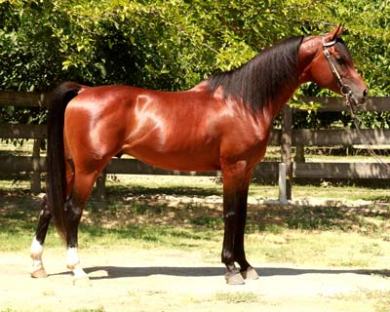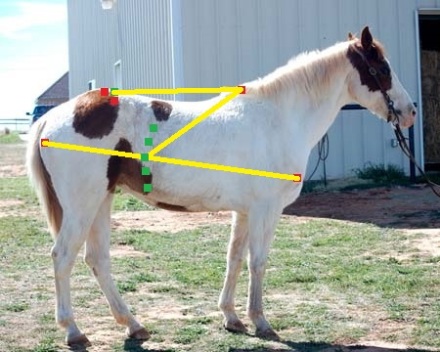There isn’t a lot of range of motion between the equine vertebrae, a lot less than people think. I mentioned in part 2a of this series that a long back isn’t necessarily more flexible than a shorter back; sometimes it is, sometimes it isn’t. And here’s why:
The back is made up of thoracic vertebrae and lumbar vertebrae. The thoracic vertebrae have more range of motion between them than the lumbar vertebrae. Indeed, the lumbar vertebrae are all but fused in the adult horse to help add stability and strength to that section of the back, which is the weakest and most susceptible because it’s a freespan having no ribs to support it. Youngsters show more flexibility and ability to ‘twist’ than an adult because their vertebrae aren’t done growing and ‘setting’. Think of it like a baby’s skull that is soft and still in ‘pieces’ and then as the baby grows and matures the skull hardens and fuses. This is just one of the many reasons why riding young horses can be detrimental to future soundness and it’s also a main reason why so many racehorses hurt their backs, but that’s a topic for another day.
If a horse has a medium length of back, but a loin that is proportionately long, then that horse will have less lateral flexibility than a horse with the same medium length of back, but with a loin that is proportionately shorter. Let me phrase it another way: the longer the loin proportionately, the longer the freespan of relatively immobile vertebrae, therefore, the less lateral back flexibility.
So now we want to take a closer look at our six horse’s backs and determine how much potential flexibility they possess. First we want to see how far the ribcage carries back. (I’m saving the loin for our final part of the series.) The further the ribcage carries back, the more strength it adds to the back (similar to withers that carry back well), AND the more potential for lateral flexibility because that means the more thoracic vertebrae length we have proportionately.
There are two methods for determining how well the ribcage carries back; one is a ‘quick and dirty’ method and one is our trusty measure and calculate method. We’ll start with the latter.
- A horse with the maximum potential for lateral flexibility (which, btw, is the ability to perform a volte or 6m circle) will possess a ribcage that exceeds 100% of its back length.
- A horse that possesses an average potential for lateral flexibility will possess a ribcage close to 100% of its back length.
- A horse that possesses a below average potential for lateral flexibility will have a ribcage well below 100% of its back length.
Remember, though, that all other things would have to be equal. For instance, a horse with a medium back that had a ribcage of 95% would have less lateral flexibility potential than a horse with the same medium back length that had a ribcage of 110%. BUT, a horse with a medium back that had a ribcage of 110% would have more lateral flexibility potential than a horse with a short back and a ribcage of 110% because the medium back possesses more thoracic length to start with than the short back regardless of having the same ribcage length. Still with me?
To determine the ribcage length we start by measuring back length (highest point of wither to LS joint). Then we draw a body length line (point of shoulder to point of buttock) and a second line from highest point of wither to the last rib. Where that second line intersects the body length line is the end point of our ribcage. We then divide the ribcage length by the back length to get our ribcage percentage.
Our skeleton with the points and lines marked:
Horse #1 – 10yr old QH Stallion
So, you’re staring at our first horse and maybe wondering where is that last rib? This is another point on a horse that can sometimes be hard to identify in a photo. It is always best to look at a horse in real life, make a guess, and then palpate to determine how close you were. Over time your eye develops and you start to be able to pick up the nuances of muscle, skin, shading and lighting that can indicate, not just in real life, but also in a photo where such a point is.
Without even measuring we can see that the ribcage line is almost as long as the back line. My measurement is about 97%, so that’s a ribcage that carries back well, adding strength and flexibility to the back. But remember, this horse had a short back, so even though the ribcage length is very good, that overall shortness does bite into potential lateral flexibility.
Horse #2 – QH Gelding
This horse doesn’t have the same muscle definition as our first, so judging where the last rib resides is more difficult.
Here’s another one where we can see the ribcage line is very close in length to the back line. This horse measures almost 95.5%, so close to horse #1. This horse also had a rather short back (just a touch longer than horse #1), so we can conclude that both horses are likely to have similar lateral flexibility potential.
Horse #3 – 4yr old QH
The sun helps a little bit here to locate that last rib.
This horse’s ribcage measures pretty much right on 100%, so carries back well and with a good amount of lateral flexibility potential. This horse also measured at the longer end of the medium spectrum, so there’s even more potential for flexibility.
Horse #4 – Arabian Stallion
Another horse with a ribcage that carries back well at 95%, but with a back length that falls on the short side.
Horse #5 – TB Gelding
How does this horse’s ribcage measure up to the previous ones?
If you guessed that this horse’s ribcage carried back the furthest, then good eye! Finally, we have a horse with an exceptional ribcage at 104%. Our TB and our grey QH had similar back lengths, being at the higher end of medium in range, but our TB has a ribcage that carries back further, so should possess a bit more lateral flexibility potential. Indeed, this horse should have the most potential of any of the other horses in that area. And lastly, remember that the further the ribcage carries back, the more strength it adds as well.
Horse #6 – Paint Mare
How far back does this horse’s ribcage carry?
Our poor Paint mare takes another hit with a ribcage that carries the least distance back at just under 91%. She also possessed our longest back of the group right at 50%. So here is a situation where longer is NOT more flexible.
Now that you’ve got the hang on the measuring method, I’ll tell you about the ‘quick and dirty’ method. Place your hand between your horse’s last rib and point of hip. More than a ‘spread’ hand’s width (8”) is a ribcage that doesn’t carry back very far. A ‘spread’ hand’s width is a ribcage that carries back well, and less than a ‘spread’ hand’s width is a ribcage that carries back very well. You cannot have a ribcage carry too far back. The further back it goes, the better.













